Zero Based Budgeting in Healthcare: A Comprehensive Analysis of Risks
VerifiedAdded on 2021/04/21
|7
|1515
|80
Report
AI Summary
This report provides a comprehensive overview of Zero Based Budgeting (ZBB) in healthcare, outlining its advantages, such as radical cost structure redesign and optimized spending. The analysis details how ZBB can foster efficient processes, remove unnecessary activities, and improve resource allocation, ultimately leading to a competitive edge. The report also highlights potential challenges in healthcare, including cyber security breaches, workplace violence, infection outbreaks, and telemedicine issues, emphasizing the need for additional budget allocations to mitigate these risks. Specific examples are given, such as the importance of cyber security measures, zero-tolerance policies for violence, sanitation practices to prevent infection, and proper training for telemedicine professionals. The conclusion reinforces the importance of ZBB for healthcare organizations, advocating for adequate funding to address and reduce the impact of unexpected events. The report is supported by references to relevant literature on the subject.
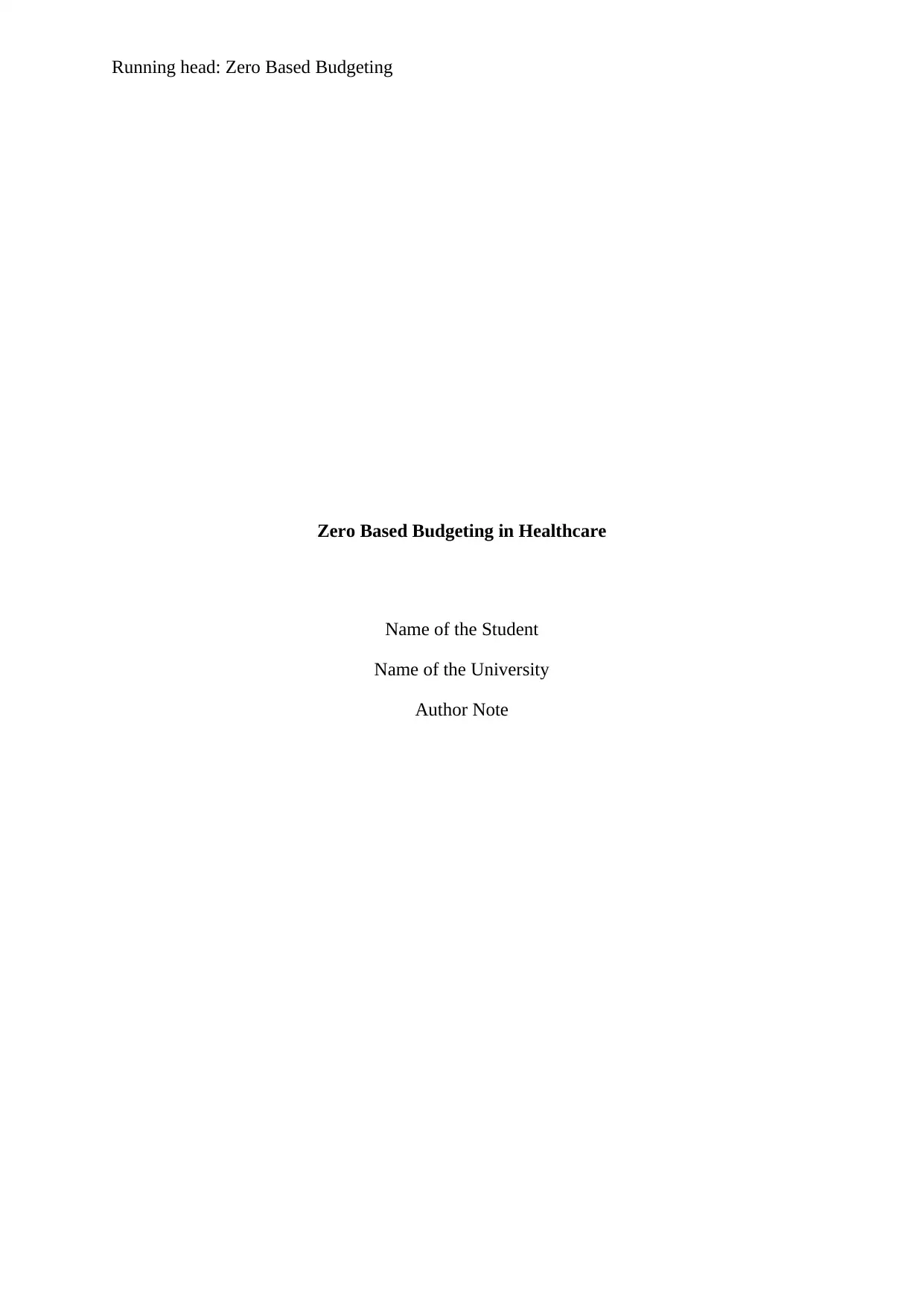
Running head: Zero Based Budgeting
Zero Based Budgeting in Healthcare
Name of the Student
Name of the University
Author Note
Zero Based Budgeting in Healthcare
Name of the Student
Name of the University
Author Note
Paraphrase This Document
Need a fresh take? Get an instant paraphrase of this document with our AI Paraphraser
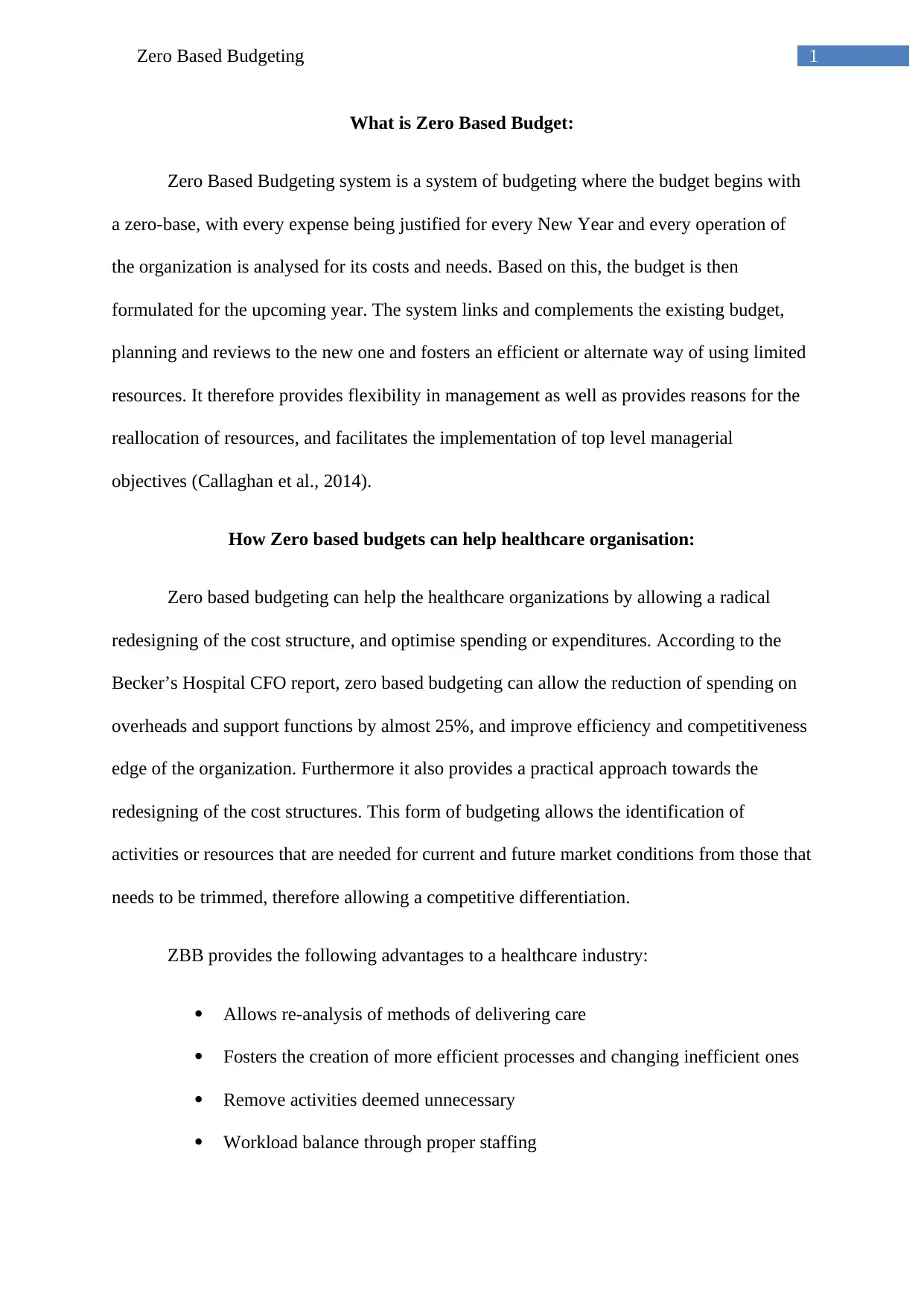
1Zero Based Budgeting
What is Zero Based Budget:
Zero Based Budgeting system is a system of budgeting where the budget begins with
a zero-base, with every expense being justified for every New Year and every operation of
the organization is analysed for its costs and needs. Based on this, the budget is then
formulated for the upcoming year. The system links and complements the existing budget,
planning and reviews to the new one and fosters an efficient or alternate way of using limited
resources. It therefore provides flexibility in management as well as provides reasons for the
reallocation of resources, and facilitates the implementation of top level managerial
objectives (Callaghan et al., 2014).
How Zero based budgets can help healthcare organisation:
Zero based budgeting can help the healthcare organizations by allowing a radical
redesigning of the cost structure, and optimise spending or expenditures. According to the
Becker’s Hospital CFO report, zero based budgeting can allow the reduction of spending on
overheads and support functions by almost 25%, and improve efficiency and competitiveness
edge of the organization. Furthermore it also provides a practical approach towards the
redesigning of the cost structures. This form of budgeting allows the identification of
activities or resources that are needed for current and future market conditions from those that
needs to be trimmed, therefore allowing a competitive differentiation.
ZBB provides the following advantages to a healthcare industry:
Allows re-analysis of methods of delivering care
Fosters the creation of more efficient processes and changing inefficient ones
Remove activities deemed unnecessary
Workload balance through proper staffing
What is Zero Based Budget:
Zero Based Budgeting system is a system of budgeting where the budget begins with
a zero-base, with every expense being justified for every New Year and every operation of
the organization is analysed for its costs and needs. Based on this, the budget is then
formulated for the upcoming year. The system links and complements the existing budget,
planning and reviews to the new one and fosters an efficient or alternate way of using limited
resources. It therefore provides flexibility in management as well as provides reasons for the
reallocation of resources, and facilitates the implementation of top level managerial
objectives (Callaghan et al., 2014).
How Zero based budgets can help healthcare organisation:
Zero based budgeting can help the healthcare organizations by allowing a radical
redesigning of the cost structure, and optimise spending or expenditures. According to the
Becker’s Hospital CFO report, zero based budgeting can allow the reduction of spending on
overheads and support functions by almost 25%, and improve efficiency and competitiveness
edge of the organization. Furthermore it also provides a practical approach towards the
redesigning of the cost structures. This form of budgeting allows the identification of
activities or resources that are needed for current and future market conditions from those that
needs to be trimmed, therefore allowing a competitive differentiation.
ZBB provides the following advantages to a healthcare industry:
Allows re-analysis of methods of delivering care
Fosters the creation of more efficient processes and changing inefficient ones
Remove activities deemed unnecessary
Workload balance through proper staffing
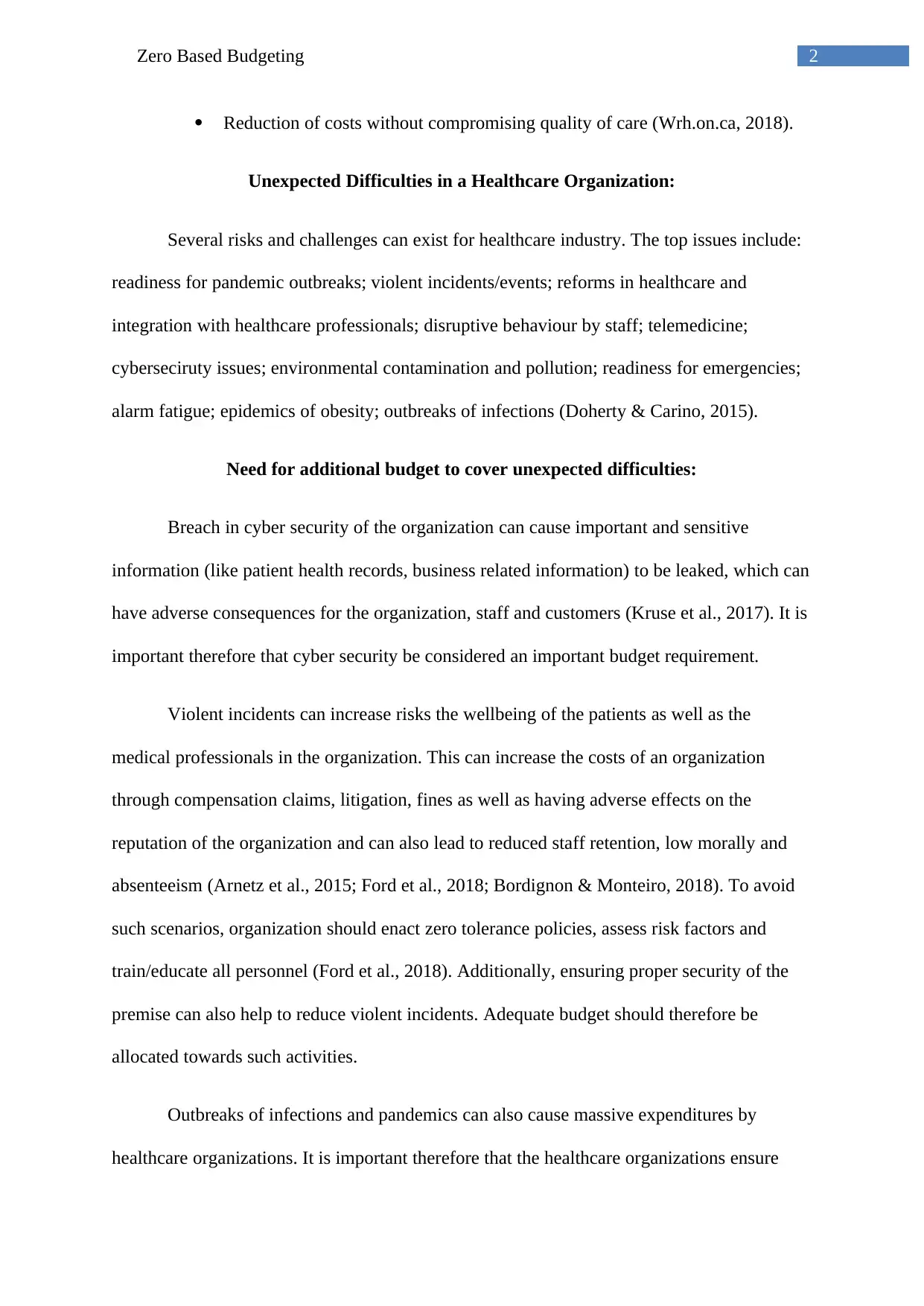
2Zero Based Budgeting
Reduction of costs without compromising quality of care (Wrh.on.ca, 2018).
Unexpected Difficulties in a Healthcare Organization:
Several risks and challenges can exist for healthcare industry. The top issues include:
readiness for pandemic outbreaks; violent incidents/events; reforms in healthcare and
integration with healthcare professionals; disruptive behaviour by staff; telemedicine;
cyberseciruty issues; environmental contamination and pollution; readiness for emergencies;
alarm fatigue; epidemics of obesity; outbreaks of infections (Doherty & Carino, 2015).
Need for additional budget to cover unexpected difficulties:
Breach in cyber security of the organization can cause important and sensitive
information (like patient health records, business related information) to be leaked, which can
have adverse consequences for the organization, staff and customers (Kruse et al., 2017). It is
important therefore that cyber security be considered an important budget requirement.
Violent incidents can increase risks the wellbeing of the patients as well as the
medical professionals in the organization. This can increase the costs of an organization
through compensation claims, litigation, fines as well as having adverse effects on the
reputation of the organization and can also lead to reduced staff retention, low morally and
absenteeism (Arnetz et al., 2015; Ford et al., 2018; Bordignon & Monteiro, 2018). To avoid
such scenarios, organization should enact zero tolerance policies, assess risk factors and
train/educate all personnel (Ford et al., 2018). Additionally, ensuring proper security of the
premise can also help to reduce violent incidents. Adequate budget should therefore be
allocated towards such activities.
Outbreaks of infections and pandemics can also cause massive expenditures by
healthcare organizations. It is important therefore that the healthcare organizations ensure
Reduction of costs without compromising quality of care (Wrh.on.ca, 2018).
Unexpected Difficulties in a Healthcare Organization:
Several risks and challenges can exist for healthcare industry. The top issues include:
readiness for pandemic outbreaks; violent incidents/events; reforms in healthcare and
integration with healthcare professionals; disruptive behaviour by staff; telemedicine;
cyberseciruty issues; environmental contamination and pollution; readiness for emergencies;
alarm fatigue; epidemics of obesity; outbreaks of infections (Doherty & Carino, 2015).
Need for additional budget to cover unexpected difficulties:
Breach in cyber security of the organization can cause important and sensitive
information (like patient health records, business related information) to be leaked, which can
have adverse consequences for the organization, staff and customers (Kruse et al., 2017). It is
important therefore that cyber security be considered an important budget requirement.
Violent incidents can increase risks the wellbeing of the patients as well as the
medical professionals in the organization. This can increase the costs of an organization
through compensation claims, litigation, fines as well as having adverse effects on the
reputation of the organization and can also lead to reduced staff retention, low morally and
absenteeism (Arnetz et al., 2015; Ford et al., 2018; Bordignon & Monteiro, 2018). To avoid
such scenarios, organization should enact zero tolerance policies, assess risk factors and
train/educate all personnel (Ford et al., 2018). Additionally, ensuring proper security of the
premise can also help to reduce violent incidents. Adequate budget should therefore be
allocated towards such activities.
Outbreaks of infections and pandemics can also cause massive expenditures by
healthcare organizations. It is important therefore that the healthcare organizations ensure
⊘ This is a preview!⊘
Do you want full access?
Subscribe today to unlock all pages.

Trusted by 1+ million students worldwide
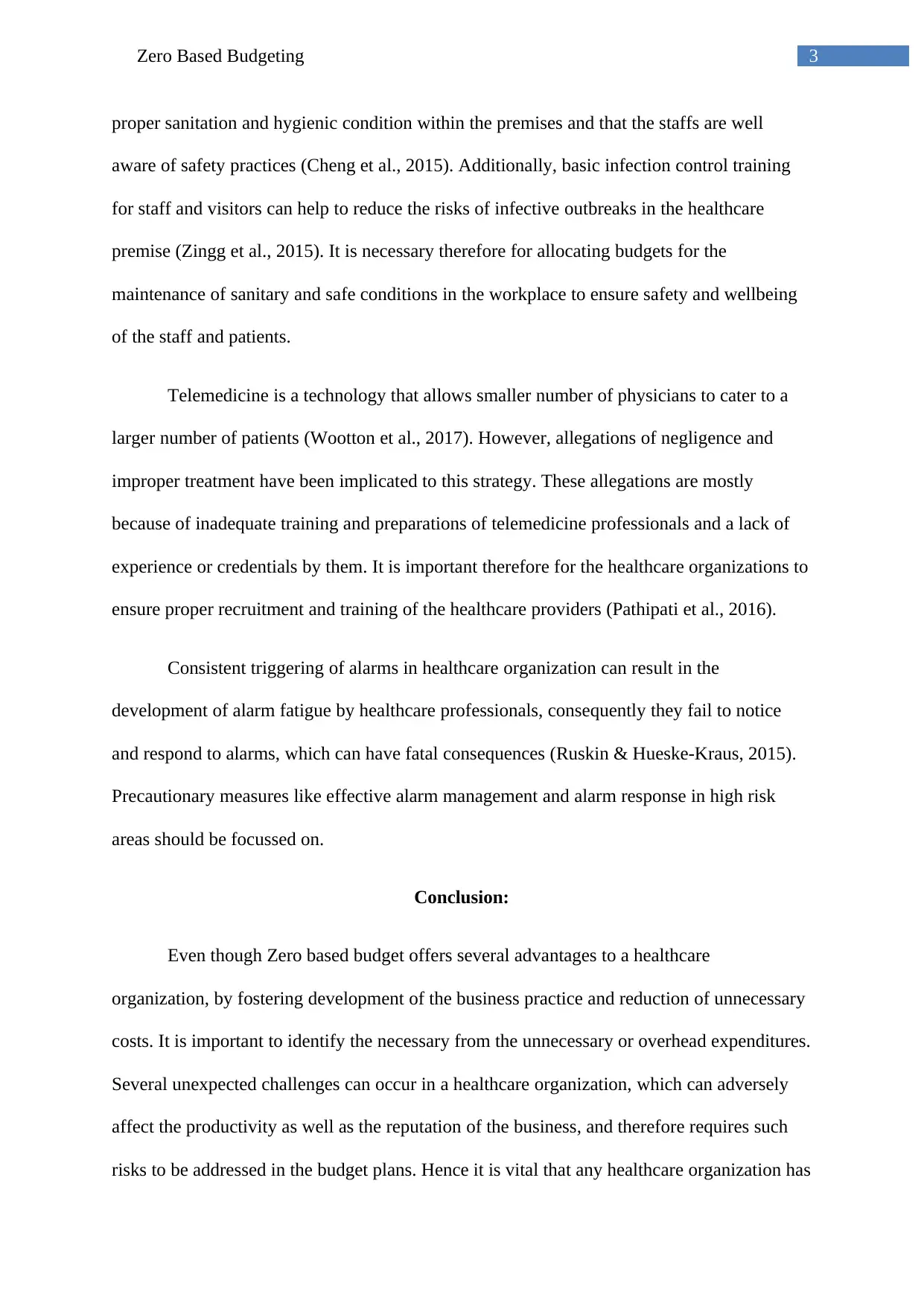
3Zero Based Budgeting
proper sanitation and hygienic condition within the premises and that the staffs are well
aware of safety practices (Cheng et al., 2015). Additionally, basic infection control training
for staff and visitors can help to reduce the risks of infective outbreaks in the healthcare
premise (Zingg et al., 2015). It is necessary therefore for allocating budgets for the
maintenance of sanitary and safe conditions in the workplace to ensure safety and wellbeing
of the staff and patients.
Telemedicine is a technology that allows smaller number of physicians to cater to a
larger number of patients (Wootton et al., 2017). However, allegations of negligence and
improper treatment have been implicated to this strategy. These allegations are mostly
because of inadequate training and preparations of telemedicine professionals and a lack of
experience or credentials by them. It is important therefore for the healthcare organizations to
ensure proper recruitment and training of the healthcare providers (Pathipati et al., 2016).
Consistent triggering of alarms in healthcare organization can result in the
development of alarm fatigue by healthcare professionals, consequently they fail to notice
and respond to alarms, which can have fatal consequences (Ruskin & Hueske-Kraus, 2015).
Precautionary measures like effective alarm management and alarm response in high risk
areas should be focussed on.
Conclusion:
Even though Zero based budget offers several advantages to a healthcare
organization, by fostering development of the business practice and reduction of unnecessary
costs. It is important to identify the necessary from the unnecessary or overhead expenditures.
Several unexpected challenges can occur in a healthcare organization, which can adversely
affect the productivity as well as the reputation of the business, and therefore requires such
risks to be addressed in the budget plans. Hence it is vital that any healthcare organization has
proper sanitation and hygienic condition within the premises and that the staffs are well
aware of safety practices (Cheng et al., 2015). Additionally, basic infection control training
for staff and visitors can help to reduce the risks of infective outbreaks in the healthcare
premise (Zingg et al., 2015). It is necessary therefore for allocating budgets for the
maintenance of sanitary and safe conditions in the workplace to ensure safety and wellbeing
of the staff and patients.
Telemedicine is a technology that allows smaller number of physicians to cater to a
larger number of patients (Wootton et al., 2017). However, allegations of negligence and
improper treatment have been implicated to this strategy. These allegations are mostly
because of inadequate training and preparations of telemedicine professionals and a lack of
experience or credentials by them. It is important therefore for the healthcare organizations to
ensure proper recruitment and training of the healthcare providers (Pathipati et al., 2016).
Consistent triggering of alarms in healthcare organization can result in the
development of alarm fatigue by healthcare professionals, consequently they fail to notice
and respond to alarms, which can have fatal consequences (Ruskin & Hueske-Kraus, 2015).
Precautionary measures like effective alarm management and alarm response in high risk
areas should be focussed on.
Conclusion:
Even though Zero based budget offers several advantages to a healthcare
organization, by fostering development of the business practice and reduction of unnecessary
costs. It is important to identify the necessary from the unnecessary or overhead expenditures.
Several unexpected challenges can occur in a healthcare organization, which can adversely
affect the productivity as well as the reputation of the business, and therefore requires such
risks to be addressed in the budget plans. Hence it is vital that any healthcare organization has
Paraphrase This Document
Need a fresh take? Get an instant paraphrase of this document with our AI Paraphraser

4Zero Based Budgeting
adequate funds allocated towards systems that can reduce the risks of such incidents or
reduce such challenges.
adequate funds allocated towards systems that can reduce the risks of such incidents or
reduce such challenges.
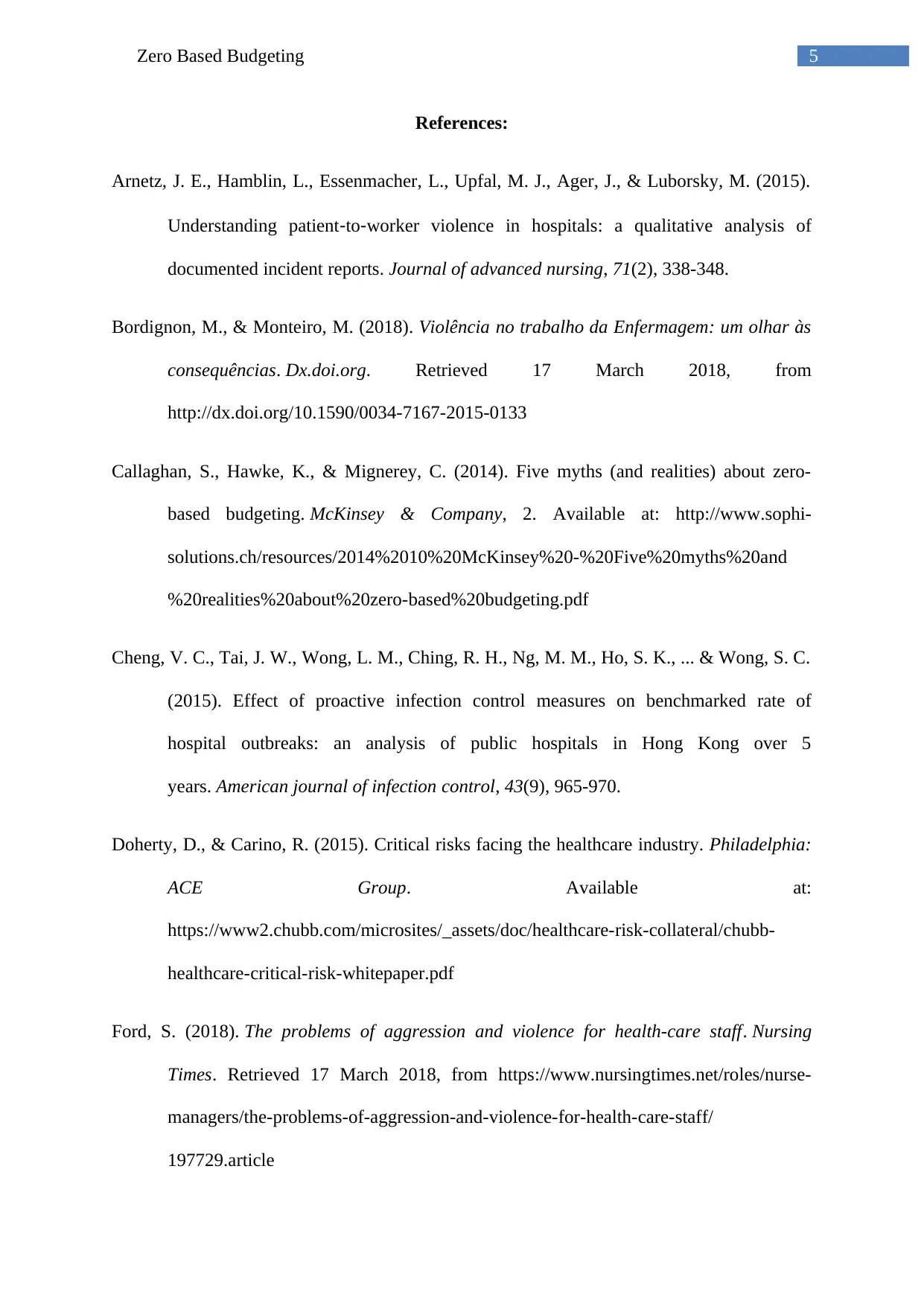
5Zero Based Budgeting
References:
Arnetz, J. E., Hamblin, L., Essenmacher, L., Upfal, M. J., Ager, J., & Luborsky, M. (2015).
Understanding patient‐to‐worker violence in hospitals: a qualitative analysis of
documented incident reports. Journal of advanced nursing, 71(2), 338-348.
Bordignon, M., & Monteiro, M. (2018). Violência no trabalho da Enfermagem: um olhar às
consequências. Dx.doi.org. Retrieved 17 March 2018, from
http://dx.doi.org/10.1590/0034-7167-2015-0133
Callaghan, S., Hawke, K., & Mignerey, C. (2014). Five myths (and realities) about zero-
based budgeting. McKinsey & Company, 2. Available at: http://www.sophi-
solutions.ch/resources/2014%2010%20McKinsey%20-%20Five%20myths%20and
%20realities%20about%20zero-based%20budgeting.pdf
Cheng, V. C., Tai, J. W., Wong, L. M., Ching, R. H., Ng, M. M., Ho, S. K., ... & Wong, S. C.
(2015). Effect of proactive infection control measures on benchmarked rate of
hospital outbreaks: an analysis of public hospitals in Hong Kong over 5
years. American journal of infection control, 43(9), 965-970.
Doherty, D., & Carino, R. (2015). Critical risks facing the healthcare industry. Philadelphia:
ACE Group. Available at:
https://www2.chubb.com/microsites/_assets/doc/healthcare-risk-collateral/chubb-
healthcare-critical-risk-whitepaper.pdf
Ford, S. (2018). The problems of aggression and violence for health-care staff. Nursing
Times. Retrieved 17 March 2018, from https://www.nursingtimes.net/roles/nurse-
managers/the-problems-of-aggression-and-violence-for-health-care-staff/
197729.article
References:
Arnetz, J. E., Hamblin, L., Essenmacher, L., Upfal, M. J., Ager, J., & Luborsky, M. (2015).
Understanding patient‐to‐worker violence in hospitals: a qualitative analysis of
documented incident reports. Journal of advanced nursing, 71(2), 338-348.
Bordignon, M., & Monteiro, M. (2018). Violência no trabalho da Enfermagem: um olhar às
consequências. Dx.doi.org. Retrieved 17 March 2018, from
http://dx.doi.org/10.1590/0034-7167-2015-0133
Callaghan, S., Hawke, K., & Mignerey, C. (2014). Five myths (and realities) about zero-
based budgeting. McKinsey & Company, 2. Available at: http://www.sophi-
solutions.ch/resources/2014%2010%20McKinsey%20-%20Five%20myths%20and
%20realities%20about%20zero-based%20budgeting.pdf
Cheng, V. C., Tai, J. W., Wong, L. M., Ching, R. H., Ng, M. M., Ho, S. K., ... & Wong, S. C.
(2015). Effect of proactive infection control measures on benchmarked rate of
hospital outbreaks: an analysis of public hospitals in Hong Kong over 5
years. American journal of infection control, 43(9), 965-970.
Doherty, D., & Carino, R. (2015). Critical risks facing the healthcare industry. Philadelphia:
ACE Group. Available at:
https://www2.chubb.com/microsites/_assets/doc/healthcare-risk-collateral/chubb-
healthcare-critical-risk-whitepaper.pdf
Ford, S. (2018). The problems of aggression and violence for health-care staff. Nursing
Times. Retrieved 17 March 2018, from https://www.nursingtimes.net/roles/nurse-
managers/the-problems-of-aggression-and-violence-for-health-care-staff/
197729.article
⊘ This is a preview!⊘
Do you want full access?
Subscribe today to unlock all pages.

Trusted by 1+ million students worldwide
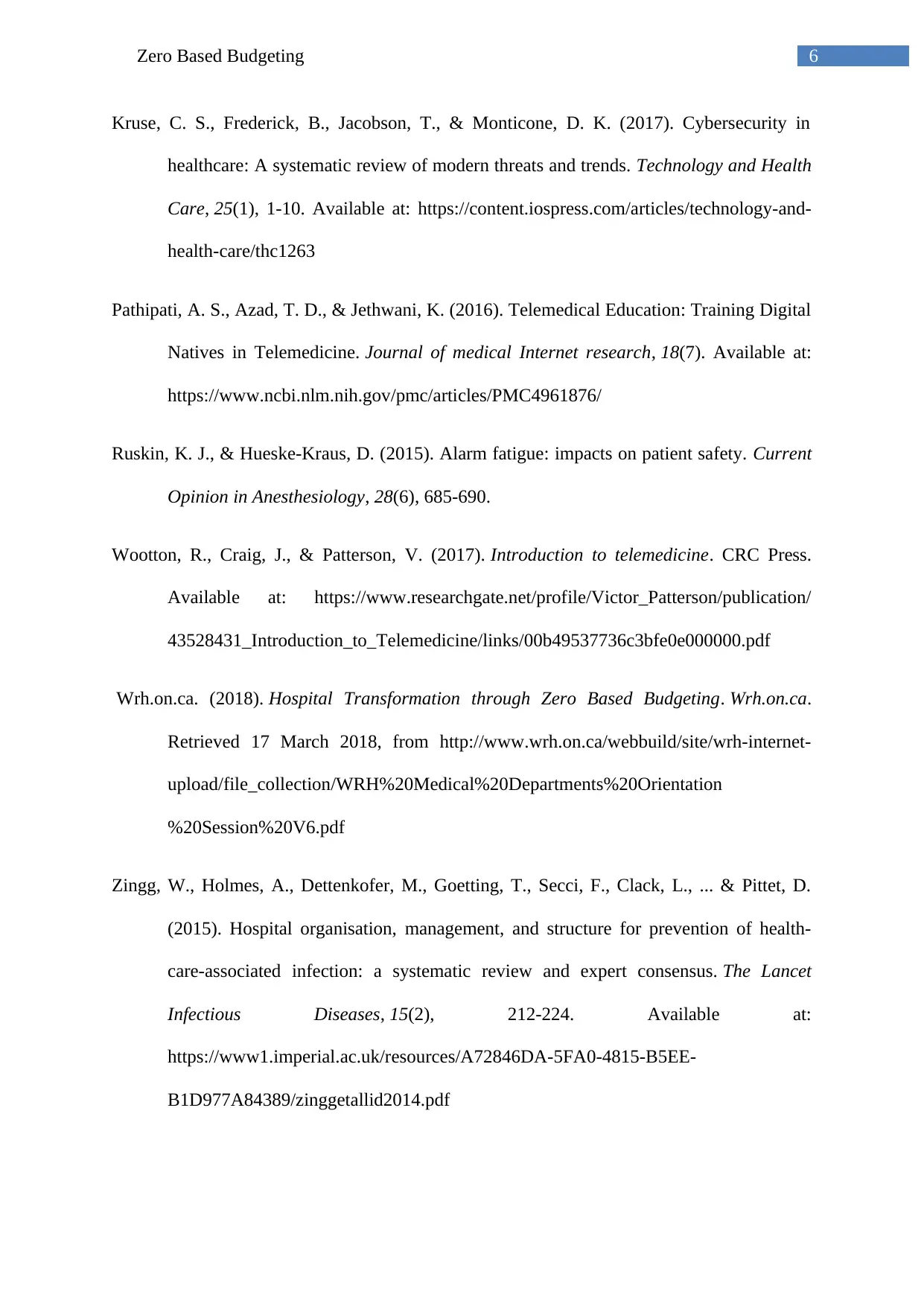
6Zero Based Budgeting
Kruse, C. S., Frederick, B., Jacobson, T., & Monticone, D. K. (2017). Cybersecurity in
healthcare: A systematic review of modern threats and trends. Technology and Health
Care, 25(1), 1-10. Available at: https://content.iospress.com/articles/technology-and-
health-care/thc1263
Pathipati, A. S., Azad, T. D., & Jethwani, K. (2016). Telemedical Education: Training Digital
Natives in Telemedicine. Journal of medical Internet research, 18(7). Available at:
https://www.ncbi.nlm.nih.gov/pmc/articles/PMC4961876/
Ruskin, K. J., & Hueske-Kraus, D. (2015). Alarm fatigue: impacts on patient safety. Current
Opinion in Anesthesiology, 28(6), 685-690.
Wootton, R., Craig, J., & Patterson, V. (2017). Introduction to telemedicine. CRC Press.
Available at: https://www.researchgate.net/profile/Victor_Patterson/publication/
43528431_Introduction_to_Telemedicine/links/00b49537736c3bfe0e000000.pdf
Wrh.on.ca. (2018). Hospital Transformation through Zero Based Budgeting. Wrh.on.ca.
Retrieved 17 March 2018, from http://www.wrh.on.ca/webbuild/site/wrh-internet-
upload/file_collection/WRH%20Medical%20Departments%20Orientation
%20Session%20V6.pdf
Zingg, W., Holmes, A., Dettenkofer, M., Goetting, T., Secci, F., Clack, L., ... & Pittet, D.
(2015). Hospital organisation, management, and structure for prevention of health-
care-associated infection: a systematic review and expert consensus. The Lancet
Infectious Diseases, 15(2), 212-224. Available at:
https://www1.imperial.ac.uk/resources/A72846DA-5FA0-4815-B5EE-
B1D977A84389/zinggetallid2014.pdf
Kruse, C. S., Frederick, B., Jacobson, T., & Monticone, D. K. (2017). Cybersecurity in
healthcare: A systematic review of modern threats and trends. Technology and Health
Care, 25(1), 1-10. Available at: https://content.iospress.com/articles/technology-and-
health-care/thc1263
Pathipati, A. S., Azad, T. D., & Jethwani, K. (2016). Telemedical Education: Training Digital
Natives in Telemedicine. Journal of medical Internet research, 18(7). Available at:
https://www.ncbi.nlm.nih.gov/pmc/articles/PMC4961876/
Ruskin, K. J., & Hueske-Kraus, D. (2015). Alarm fatigue: impacts on patient safety. Current
Opinion in Anesthesiology, 28(6), 685-690.
Wootton, R., Craig, J., & Patterson, V. (2017). Introduction to telemedicine. CRC Press.
Available at: https://www.researchgate.net/profile/Victor_Patterson/publication/
43528431_Introduction_to_Telemedicine/links/00b49537736c3bfe0e000000.pdf
Wrh.on.ca. (2018). Hospital Transformation through Zero Based Budgeting. Wrh.on.ca.
Retrieved 17 March 2018, from http://www.wrh.on.ca/webbuild/site/wrh-internet-
upload/file_collection/WRH%20Medical%20Departments%20Orientation
%20Session%20V6.pdf
Zingg, W., Holmes, A., Dettenkofer, M., Goetting, T., Secci, F., Clack, L., ... & Pittet, D.
(2015). Hospital organisation, management, and structure for prevention of health-
care-associated infection: a systematic review and expert consensus. The Lancet
Infectious Diseases, 15(2), 212-224. Available at:
https://www1.imperial.ac.uk/resources/A72846DA-5FA0-4815-B5EE-
B1D977A84389/zinggetallid2014.pdf
1 out of 7
Your All-in-One AI-Powered Toolkit for Academic Success.
+13062052269
info@desklib.com
Available 24*7 on WhatsApp / Email
![[object Object]](/_next/static/media/star-bottom.7253800d.svg)
Unlock your academic potential
Copyright © 2020–2025 A2Z Services. All Rights Reserved. Developed and managed by ZUCOL.

